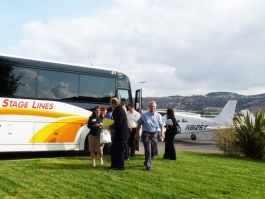

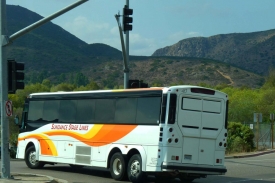
By Miriam Raftery
November 6, 2011 (San Diego’s East County) –“This is a historic time for East County,” Jo Marie Diamond, president and chief executive officer of the East Count Economic Development Council (ECEDC) told guests at last week’s “Sky’s the limit” bus tour of East County. Three busloads of business leaders rolled through our region's urban, suburban, and small town communities, learning some surprising facts along the way.
If you haven’t traveled through East County in a while, you may be surprised at the many recent changes.
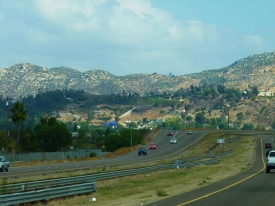 Access to the “sunny side of San Diego” in East County has dramatically improved due to recently opened new freeways that place East County within 20 minutes of La Jolla, downtown, and the South Bay areas.
Access to the “sunny side of San Diego” in East County has dramatically improved due to recently opened new freeways that place East County within 20 minutes of La Jolla, downtown, and the South Bay areas.
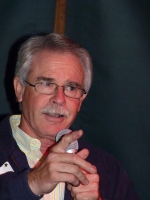 “The traffic goes the other way out here,” quipped Don Parent, spokesman for San Diego Gas & Electric (SDG&E), principal sponsor of the event.
“The traffic goes the other way out here,” quipped Don Parent, spokesman for San Diego Gas & Electric (SDG&E), principal sponsor of the event.
La Mesa and El Cajon are gearing up for their centennial celebrations next year. Despite the recession, growth is booming in some areas, such as Santee, no longer a rural backwater but a burgeoning bedroom community with a thriving retail base, new housing, parks and Sportsplex.
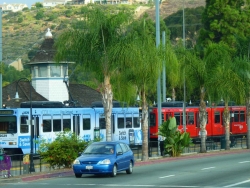 Lemon Grove has razed a city block in preparation for a major downtown mixed use redevelopment. In Lakeside, the Lakeside Riverpark Conservancy has created beautiful river walk trails through restoration of riparian habitat reclaimed from sand mining operations. Modern industrial parks have sprung up in some areas, while the community’s heart retains its rustic Western charm and yes, the Lakeside Rodeo grounds.
Lemon Grove has razed a city block in preparation for a major downtown mixed use redevelopment. In Lakeside, the Lakeside Riverpark Conservancy has created beautiful river walk trails through restoration of riparian habitat reclaimed from sand mining operations. Modern industrial parks have sprung up in some areas, while the community’s heart retains its rustic Western charm and yes, the Lakeside Rodeo grounds.
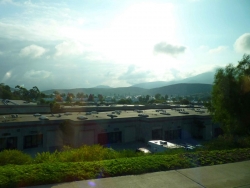 Spring Valley offers affordable industrial spaces for start-up companies and is also home to Deering Banjo, maker of musical instruments used by top performers worldwide.
Spring Valley offers affordable industrial spaces for start-up companies and is also home to Deering Banjo, maker of musical instruments used by top performers worldwide. 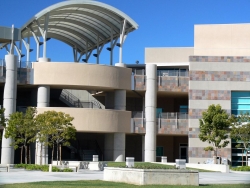
In Rancho San Diego, beautiful new buildings have sprouted at Cuyamaca College, where the curriculum includes green jobs training; high-end homes and retail centers abound. Native American gaming, hotels, and championship golf courses have further transformed East County from the sleepy backwater of yesteryear.
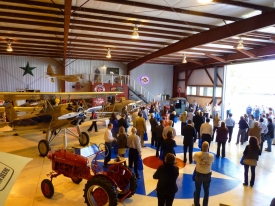 The tour name alludes to the “Aerotropolis” redevelopment concept rolled out by the ECEDC for the area around Gillespie Field, an area of burgeoning industrial parks with ample room for aerospace and aviation related businesses.
The tour name alludes to the “Aerotropolis” redevelopment concept rolled out by the ECEDC for the area around Gillespie Field, an area of burgeoning industrial parks with ample room for aerospace and aviation related businesses.
The tour  included a drive down the runway and a stop at the Allen Airways Flying Museum, a private facility which houses an impressive collection of vintage airplanes and memorabilia, including an aviation poster collection displayed at the Smithsonian.
included a drive down the runway and a stop at the Allen Airways Flying Museum, a private facility which houses an impressive collection of vintage airplanes and memorabilia, including an aviation poster collection displayed at the Smithsonian.
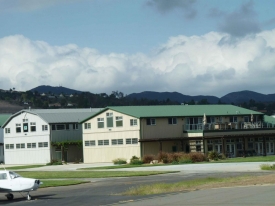 Along the runways, revamped hangars now offer upstairs overnight accommodations for pilots complete with balconies, ideal for business travelers as part of the Aerotropolis concept.
Along the runways, revamped hangars now offer upstairs overnight accommodations for pilots complete with balconies, ideal for business travelers as part of the Aerotropolis concept.
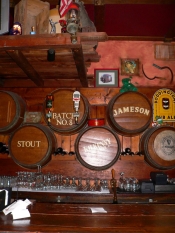 Eric Lund with the San Diego Convention & Visitors bureau doubled as tour guide on one of three busses rolling out from Hooleys Irish Pub & Grill in Rancho San Diego, where tour goers savored Irish coffee and a continental breakfast amid a restaurant made from authentic pub elements imported from Ireland.
Eric Lund with the San Diego Convention & Visitors bureau doubled as tour guide on one of three busses rolling out from Hooleys Irish Pub & Grill in Rancho San Diego, where tour goers savored Irish coffee and a continental breakfast amid a restaurant made from authentic pub elements imported from Ireland.
“East County has a wide range of housing, education, economic and cultural benefits,” he said.
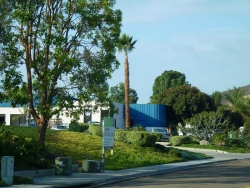 Along the way, Lund rattled off stats on each of the incorporated cities and several unincorporated communities. First came Spring Valley, with a population of 100,000 occupying 13.5 square miles – a place where the median housing cost is still just $255,000 and 100,000 square feet of 1.7 million industrial square feet are currently vacant.
Along the way, Lund rattled off stats on each of the incorporated cities and several unincorporated communities. First came Spring Valley, with a population of 100,000 occupying 13.5 square miles – a place where the median housing cost is still just $255,000 and 100,000 square feet of 1.7 million industrial square feet are currently vacant. 
“The entire spectrum of product development life cycle is here,” said Diamond, adding that the area also now has a community garden, farmer’s market and new ballfields. Higher end homes cluster atop Dictionary Hill (originally named Encyclopedia Hill by a developer who gave away encyclopedia sets to buyers).
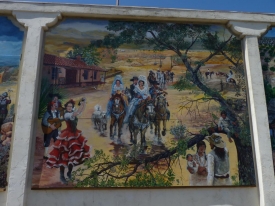 Next the busses rolled through Lemon Grove, now one of the most ethnically diverse communities in California yet still retaining its small town roots with a community bonfire and outdoor summer concerts.
Next the busses rolled through Lemon Grove, now one of the most ethnically diverse communities in California yet still retaining its small town roots with a community bonfire and outdoor summer concerts.
The town has a population of 20,000 in 3.9 square miles, with even more affordable housing at a $218,000 median price. Historic murals on the Grove Bakery’s exterior wall portray the town’s heritage, from Kumeyaay Indian tribes to Spanish settlement, on through its pioneer roots.
Today, a modest industrial base has a 12.6% vacancy. The city, which has a smaller retail base than most other East County communities, has struggled with budget cuts in the current economy. But the big news in town is the start of a long-anticipated redevelopment: a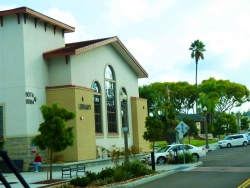 linear park with farmer’s market/community garden space next to the trolley station is now underway, along with a mixed-used, transit-friendly development aptly named Citronica-- just across from the town’s giant lemon, symbol of Lemon Grove’s agricultural roots.
linear park with farmer’s market/community garden space next to the trolley station is now underway, along with a mixed-used, transit-friendly development aptly named Citronica-- just across from the town’s giant lemon, symbol of Lemon Grove’s agricultural roots.
La Mesa, 100 years young next year, has undergone dramatic transformation with all new public buildings including a library, fire station and police station thanks to a bond measure.
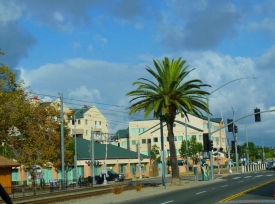 Mixed used properties and transit-friendly housing have sprung up like wildflowers after a spring rain here in a town that proudly proclaims its mottos as “the jewel of the hills.” The quaint downtown village hosts a variety of celebrations each year including Oktoberfest, Christmas in the Village, and an Antique Street Faire. In 2012, La Mesa plans to host the “party of a century” to usher in its centennial.
Mixed used properties and transit-friendly housing have sprung up like wildflowers after a spring rain here in a town that proudly proclaims its mottos as “the jewel of the hills.” The quaint downtown village hosts a variety of celebrations each year including Oktoberfest, Christmas in the Village, and an Antique Street Faire. In 2012, La Mesa plans to host the “party of a century” to usher in its centennial.
 The city has a population of 57,000 in nine square miles. Here, median home prices are $322,500. Cruising past a trolley stop and vintage railway museum, Lund reminisces, “Our first office for the San Diego East County Convention and Visitors Bureau was in that caboose.”
The city has a population of 57,000 in nine square miles. Here, median home prices are $322,500. Cruising past a trolley stop and vintage railway museum, Lund reminisces, “Our first office for the San Diego East County Convention and Visitors Bureau was in that caboose.”
La Mesa has won numerous awards for its transit-friendly development and sustainability initiatives. A glass elevator leading from a transit station to Grossmont Shopping Center is being completed with federal stimulus funds. The City is also home to Grossmont Hospital, which has a gleaming new Emergency Room and underwent a major remodel recently.
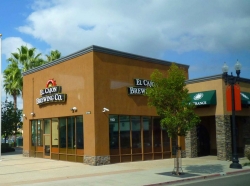 Neighboring El Cajon is also preparing for its centennial in 2012. Best known for its nationally-known Mother Goose Parade, the city also hosts classic cruise nights for vintage cars, free concerts on the green, and many other events.
Neighboring El Cajon is also preparing for its centennial in 2012. Best known for its nationally-known Mother Goose Parade, the city also hosts classic cruise nights for vintage cars, free concerts on the green, and many other events.
Downtown vacancies are gradually filling and many storefronts have undergone renovations, sprucing up the town’s historic heart. There are many outdoor cafes and restaurants now, some offering nightlife and entertainment. The brand new El Cajon Brewery ope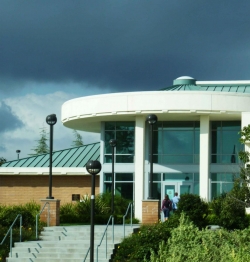 ned in October, bringing a taste of San Diego County’s thriving craft brewing industry to East County.
ned in October, bringing a taste of San Diego County’s thriving craft brewing industry to East County.
El Cajon is also a transit-friendly city, with the trolley running through downtown. Plus it is home to Westfield Parkway Plaza shopping mall, which now boasts 1.3 million square feet of retail space.
Grossmont College, where nearly 20,000 students attend, has a new student center under construction and recently completed several other new buildings including a science and technology building.
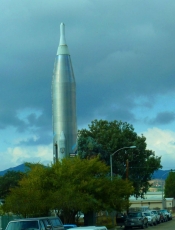 Gillespie Field, built in 1942, has a rich history--from a replica of Lindberg’s Spirit of 76 plane built here for the San Diego Aerospace Museum to a gleaming Atlas missile standing guard like a sentinel.
Gillespie Field, built in 1942, has a rich history--from a replica of Lindberg’s Spirit of 76 plane built here for the San Diego Aerospace Museum to a gleaming Atlas missile standing guard like a sentinel.
Now, the vision is to foster redevelopment to “share in the fruits and benefits” of the aerospace industry with the community. Aerospace business pumps $110 million a year into our local economy, employing 3,150 people. There is ample space for more-- and the Federal Aviation Administration’s definition of aviation-related businesses is broad.
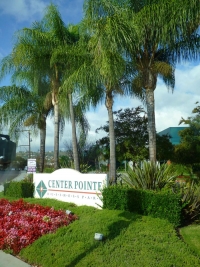 “When General Atomic ants to expand,” Diamond noted, “there’s no need to go to Poway. They can come here.” Gillespie Field itself has three runways and is home to vintage air shows each year complete with aerial dog fights and more.
“When General Atomic ants to expand,” Diamond noted, “there’s no need to go to Poway. They can come here.” Gillespie Field itself has three runways and is home to vintage air shows each year complete with aerial dog fights and more.
On a hillside above the airfield itself, new industrial parks have been built, housing a wide variety of other industries.
Heading out the new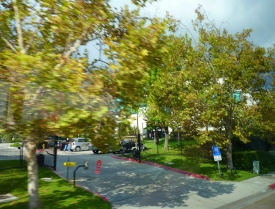 ly completed Highway 125 and onto an even newer stretch of Highway 52, we breeze past the Carlton Oaks golf course and country club.
ly completed Highway 125 and onto an even newer stretch of Highway 52, we breeze past the Carlton Oaks golf course and country club.
Next, we skirt the edge of Mission Trails 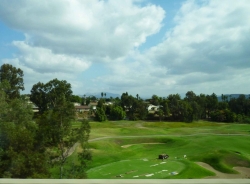 Regional Park, the largest urban park in America at over 6,200 square feet, known as the “third jewel” in San Diego’s park system, an enclave for rock climbers, hikers, and outdoor enthusiasts.
Regional Park, the largest urban park in America at over 6,200 square feet, known as the “third jewel” in San Diego’s park system, an enclave for rock climbers, hikers, and outdoor enthusiasts.
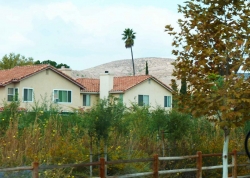 Santee has undergone probably the most significant transformation over the past decade of any East County community.
Santee has undergone probably the most significant transformation over the past decade of any East County community.
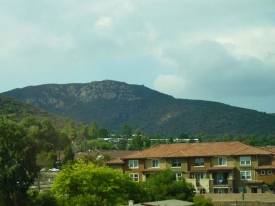 One a rural enclave, Santee now has an abundance of retail centers and restaurants, attractive townhouses and detached homes, new parks, and a Sportsplex built through a public-private partnership that has proved a profitable venture for the city.
One a rural enclave, Santee now has an abundance of retail centers and restaurants, attractive townhouses and detached homes, new parks, and a Sportsplex built through a public-private partnership that has proved a profitable venture for the city.
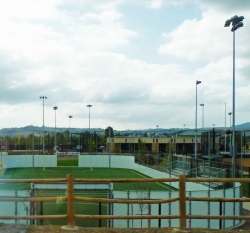 The trolley serves aptly named Santee Trolley Square, which has half a million square feet of retail space and is currently seeking new restaurant tenants. There are also many industrial spaces available . Yet there are still elements of nature, notably at Santee Lakes, which recently added floating cabins for those seeking a getaway close to home.
The trolley serves aptly named Santee Trolley Square, which has half a million square feet of retail space and is currently seeking new restaurant tenants. There are also many industrial spaces available . Yet there are still elements of nature, notably at Santee Lakes, which recently added floating cabins for those seeking a getaway close to home.
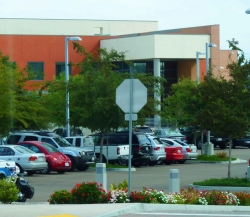 The City of Santee has a population of 58,000 and was incorporated in 1980. There are over 3.7 million square feet of industrial space, but only a 3.9% vacancy. Riverview Professional Center has 1.9 million square feet. The median housing price is still affordable at $287,750. There is also a water park, remodeled Edgemoor skilled nursing facility, which was formerly housed in an old barn.
The City of Santee has a population of 58,000 and was incorporated in 1980. There are over 3.7 million square feet of industrial space, but only a 3.9% vacancy. Riverview Professional Center has 1.9 million square feet. The median housing price is still affordable at $287,750. There is also a water park, remodeled Edgemoor skilled nursing facility, which was formerly housed in an old barn.
“Half of its land is undeveloped, so there’s still lots of room to grow,” Lund notes. Santee also boasts events ranging from a bluegrass festival to a Fourth of July fireworks extravanza, summer concerts and more.
 Lakeside, once known as a cowboy town and used as a backdrop for many Western films, now has 11,000 square feet of industrial space. The San Vicente Reservoir is undergoing the tallest dam raise in the world—117 feet.
Lakeside, once known as a cowboy town and used as a backdrop for many Western films, now has 11,000 square feet of industrial space. The San Vicente Reservoir is undergoing the tallest dam raise in the world—117 feet.
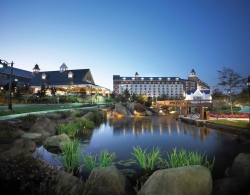 A few miles away from Lakeside’s historic district, along Wildcat Canyon Road you’ll come to the Barona Resort and Casino, which boasts the number 3-rated golf course in California along with a hotel and spa, Indian museum, pow-wow grounds and more.
A few miles away from Lakeside’s historic district, along Wildcat Canyon Road you’ll come to the Barona Resort and Casino, which boasts the number 3-rated golf course in California along with a hotel and spa, Indian museum, pow-wow grounds and more.
“The race is on to meet the need for business class hotels in several East County cities,” Lund observes.
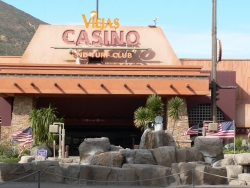 Alpine was not included on this year’s tour (perhaps because the main street is currently ripped up for undergrounding of Sunrise Powerlink Construction). However our tour guide noted that the Viejas Band of Kumeyaay Indians has plans to
Alpine was not included on this year’s tour (perhaps because the main street is currently ripped up for undergrounding of Sunrise Powerlink Construction). However our tour guide noted that the Viejas Band of Kumeyaay Indians has plans to  build a high-rise hotel adjacent to its casino, right across the street from its outlet shopping center in Alpine, where family attractions include a bowling alley, arcade, and in winter, the largest outdoor ice rink in Southern California. Alpine will be getting new streetscaping and has additional redevelopment plans in the work.
build a high-rise hotel adjacent to its casino, right across the street from its outlet shopping center in Alpine, where family attractions include a bowling alley, arcade, and in winter, the largest outdoor ice rink in Southern California. Alpine will be getting new streetscaping and has additional redevelopment plans in the work.
 Rancho San Diego is home to the Sycuan Indians, who recently completed a dramatic remodel of the Sycuan Casino, upgrading seemingly everything on the interior and added an expansive new
Rancho San Diego is home to the Sycuan Indians, who recently completed a dramatic remodel of the Sycuan Casino, upgrading seemingly everything on the interior and added an expansive new  sports bar.
sports bar.
Sycuan has also taken over the former Singing Hills golf course, where it operates a hotel and restaurant as well. Nearby Cottonwood Golf offers even more opportunities for golf aficionados.
Rancho San Diego has enclaves of upscale homes priced in the $400,000 to $500,000 range. It’s also home to a growing number of Iraqi Chaldean Christians, many of whom own businesses here. The population is 21,000 in just 8.7 square miles.
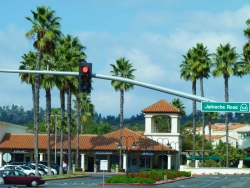 Other attractions incl
Other attractions incl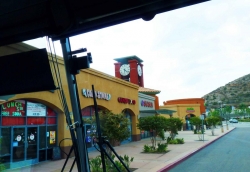 ude the Sweetwater River wildlife refuge, a brand new McGrath YMCA, new retail centers, and Cuyamaca College, which has many architecturally beautiful new buildings thanks to a bond initiative approved by residents.
ude the Sweetwater River wildlife refuge, a brand new McGrath YMCA, new retail centers, and Cuyamaca College, which has many architecturally beautiful new buildings thanks to a bond initiative approved by residents.
In addition to the ECEDC and SDG&E, other major sponsors of the tour included AT&T, Cox Communications, Grossmont Healthcare District, and the Grossmont-Cuyamaca Community College District.
Businesses seeking t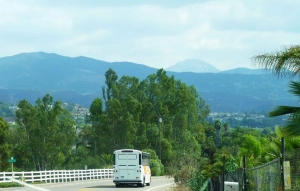 o move to East County can get help from the ECEDC as well as from www.Connectory.com , which connects up companies with local suppliers and other critical resources.
o move to East County can get help from the ECEDC as well as from www.Connectory.com , which connects up companies with local suppliers and other critical resources.
“Connectory.com, a project of East County EDC, has become the premier business-to-business information tool for the United States,” information handed out on the tour reveals, adding that the database includes every level of the supply chain and offers this information at no cost to participants. “Expansion continues,” the site concludes, “as we develop regional economic development partnerships both in California and the U.S.”
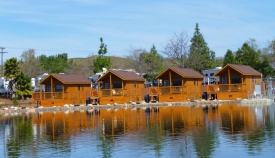 Okay, so East County isn’t ideal for everything. No surfing or ocean views. No gleaming high-rise towers or major league sports teams (though the latter is a short trolley ride away).
Okay, so East County isn’t ideal for everything. No surfing or ocean views. No gleaming high-rise towers or major league sports teams (though the latter is a short trolley ride away).
But proud East County advocates on the tour poked good-natured fun at their coastal counterparts, noting that inland areas have many advantages beyond ample space and affordability. Sunshine on cloudy days, free parking, easy commutes, lakes and rivers, plus “no sand fleas” are among the advantages noted.
 Lund said that companies moving to East County are often attracted by the affordable housing, community spirit, availability of land, economic resources, and recreational opportunities. Communities on the tour also serve as gateways to East County’s mountain and desert regions, which offer abundant outdoor recreational opportunities in all four seasons.
Lund said that companies moving to East County are often attracted by the affordable housing, community spirit, availability of land, economic resources, and recreational opportunities. Communities on the tour also serve as gateways to East County’s mountain and desert regions, which offer abundant outdoor recreational opportunities in all four seasons. 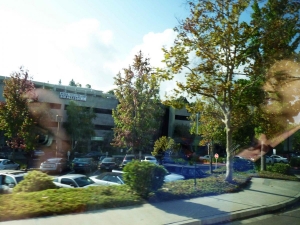
The half day tour provided many participants with new impressions of East County, leaving them much to reflect upon.







Recent comments